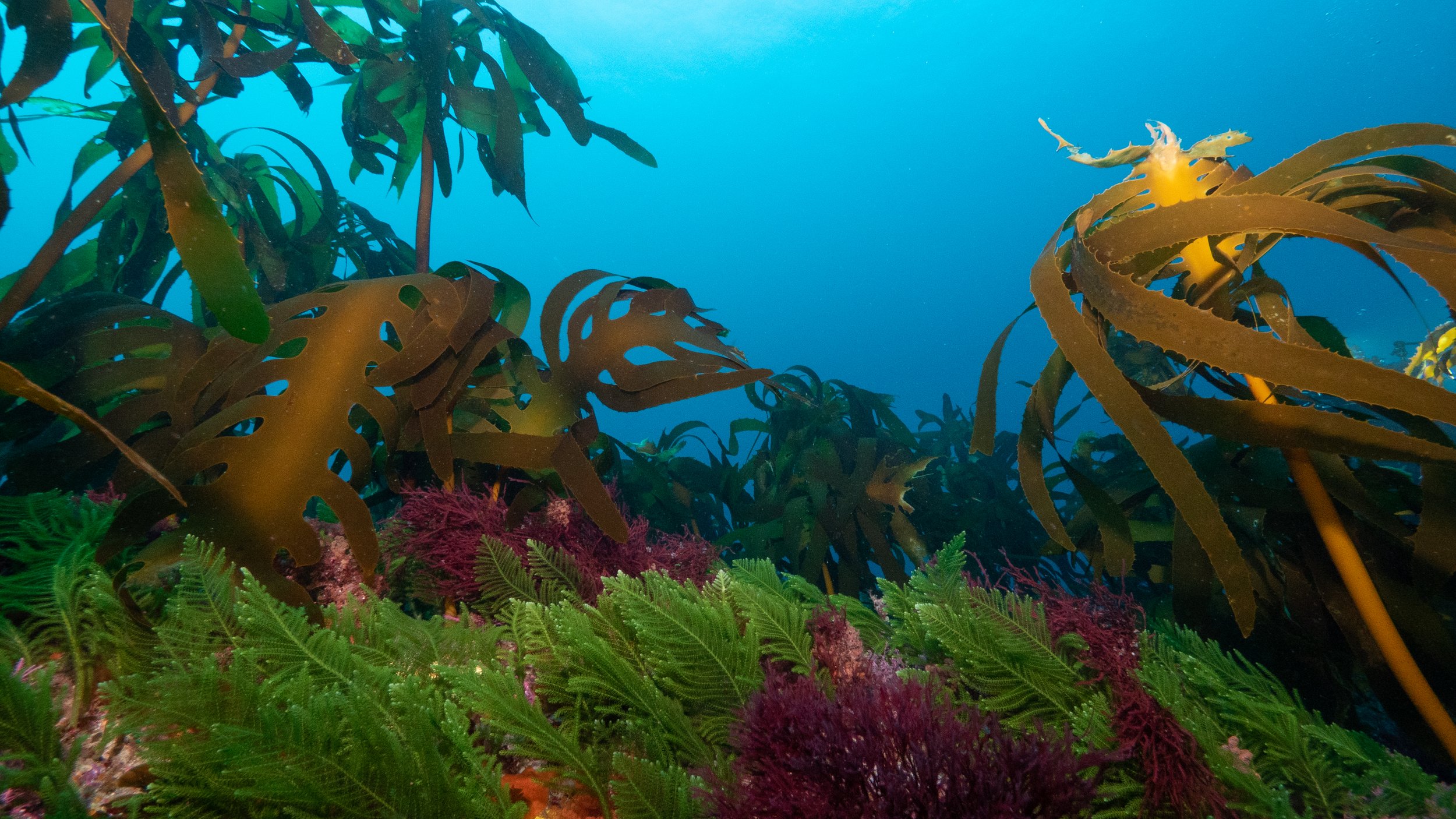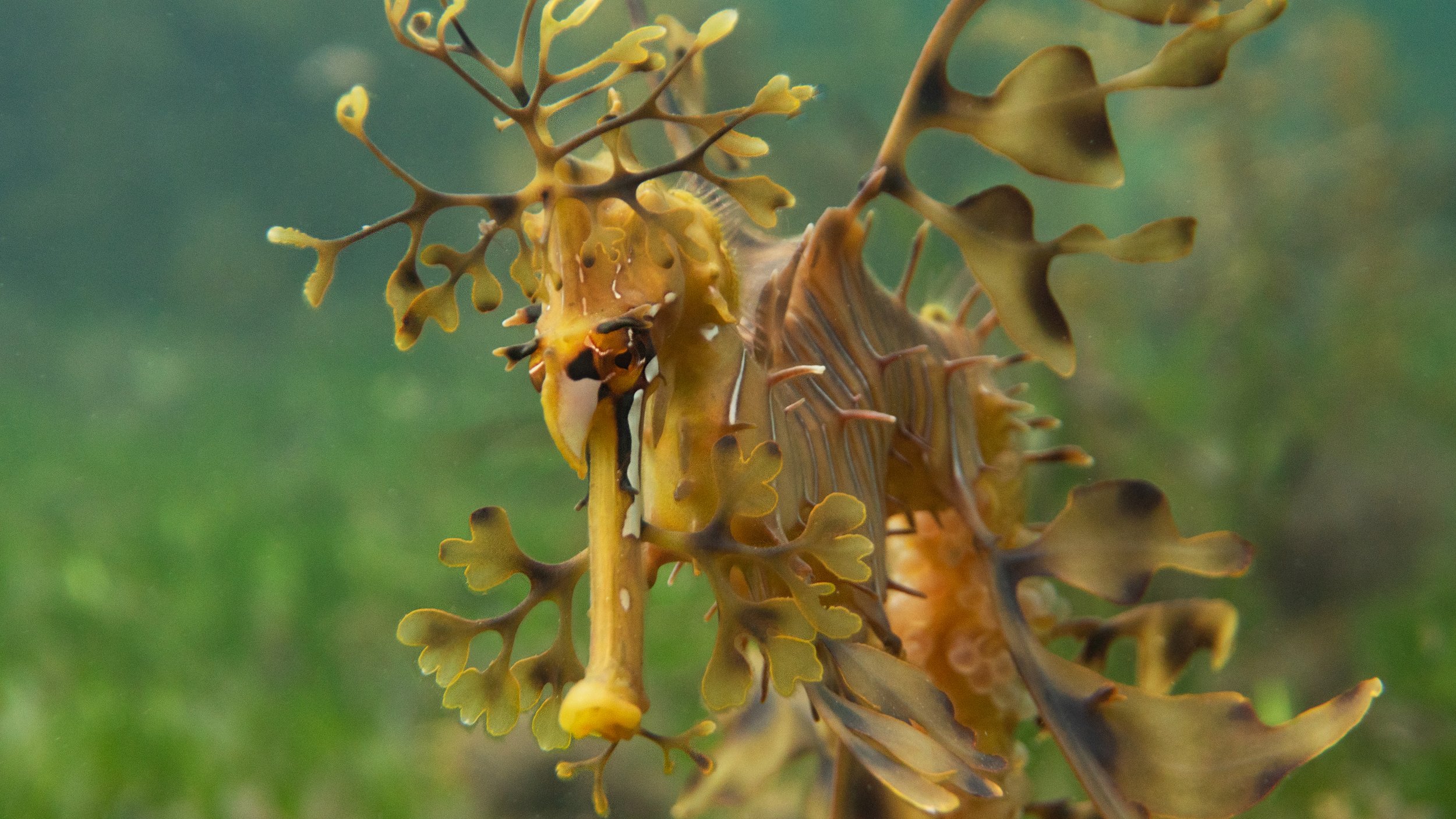
What is the great southern reef?
The Great Southern Reef (GSR) is Australia's extensive and interconnected system of temperate reefs, predominantly characterised by kelp forests. Spanning over 8,000 km of coastline across southern Australia, the GSR encompasses a diverse range of habitats from shallow rocky reefs to deep sponge gardens.
WHy is the GSR important?
The Great Southern Reef has profound ecological, cultural, and economic significance. Ecologically, it is a global biodiversity hotspot hosting a wide array of species, including a high percentage being unique to the region. The GSR supports important fisheries,tourism and recreation activity, contributing at least AU$10 billion annually to the Australian economy. It also plays a vital role in coastal protection, nutrient cycling, and carbon sequestration, supporting the livelihoods and well-being of millions of Australians. Learn more about values of the GSR.
What species can be found on the gsr?
The Great Southern Reef is a global biodiversity hotspot for marine life, with particularly high diversity of seaweeds, sponges, crustaceans, chordates, bryozoans, echinoderms, and molluscs. It boasts 1500 seaweed species, 731 species of fish, 757 species of molluscs, and over 1000 species of sponges with many undescribed species. In its deeper waters especially, the GSR is predicted to host tens of thousands more species that are yet to be discovered and described.
Learn more about marine life on the GSR
how unique are the species on the gsr?
The Great Southern Reef has more endemic seaweeds than anywhere in the world. Out of the 800+ species of red algae, 75% are unique to the region (endemic). Endemism is also very high among fish and mobile invertebrates on the Great Southern Reef, with 77% occurring nowhere else.
How is climate change affecting the gsr?
Climate change is already significantly impacting the Great Southern Reef (GSR) through various mechanisms. One of the primary effects is ocean warming, which has been particularly pronounced along the western and southeastern parts of the GSR, with warming accelerating 2–4 times faster here than the global average.
Along with ocean warming , a strengthening of poleward ocean currents and marine heatwaves have led to ecological changes in many parts of the GSR. Warming waters have facilitated the southward expansion of tropical and subtropical species into the GSR, a phenomenon known as 'tropicalisation.' This has led to increased competition for native species and altered community structures.
Specific examples of climate change induced shifts in the Great Southern Reef include:
The southward expansion of some species have caused pronounced impacts, notably the southward expansion of the long-spined sea urchin (Centrostephanus rodgersii) from the NSW and VIC coast into Tasmania, and an increase in tropical grazing fish that graze on kelp. This has led to overgrazing of kelp forests, causing significant habitat loss and altering the ecological balance of the reef system.
Once dense forests of Giant kelp (Macrocystis pyrifera) have declined by 95% on Tasmania’s East Coast and have been listed as an endangered marine community.
In Western Australia a significant marine heatwave in 2011 caused the loss of kelp from more than 960,000 hectares of the north-western GSR, along with many reef associated species including valuable abalone and lobster stocks.
Who is the great southern reef foundation?
The Great Southern Reef Foundation is run by an independent team of science, media and education professionals working to promote the recognition, stewardship and long-term health of Australia’s kelp forests. We act as knowledge brokers between science and society, to deeply embed the importance of the Great Southern Reef into Aussie culture.
The vision of the Great Southern Reef Foundation is to connect, educate and inspire society to become active stewards of Australia’s kelp forests. The GSRF represents the Great Southern Reef in key areas of Education, Community, and Science. We’re here to deepen your understanding and recognition of the Great Southern Reef.
The Great Southern Reef was incorporated in 2023 as a not-for-profit charity - the foundation is registered with the ACNC and annual financial information is available via the charity’s profile on the ACNC website.
Learn more about the Great Southern Reef Foundation team here and you can learn more about our initiatives here.
who is the gsr science committee?
Comprising eminent and emerging temperate reef scientists from across Australia, the Great Southern Reef Foundation’s Science Committee aims to become a principal reference point for government, industry, and managers, offering a holistic national perspective on temperate reefs. Learn more about the scientists in the GSRF science committee which include Scott Bennett, Thomas Wernberg, Gretta Pecl, Adriana Verges, Prue Fancis, Sean Connell, Scott Ling and Melinda Coleman.
Meet the Scientists
what are the research priorities for the gsr?
Despite its ecological significance and vast extent, research on the Great Southern Reef has historically been underfunded and consequently many knowledge areas are under-researched. This lack of focus and investment has limited our understanding of the GSR's unique biodiversity, ecological processes, and the impacts of human activities on its health and resilience.
To address this knowledge gap and ensure the long-term protection of the GSR, several research priorities have been identified by the Great Southern Reef Research Partnership including:
National monitoring: Establishing a comprehensive national monitoring framework to assess the biodiversity within the GSR, both inside and outside protected areas. This will help in understanding the baseline conditions and tracking changes over time, which is crucial for effective management and conservation efforts.
Comprehensive studies of the reef’s Health: Focusing system-wide assessments of the reef's critical ecological processes. These health-checks are vital for gaining insights into the factors that influence the stability, and resilience of the GSR, aiding in the development of strategies to mitigate threats.
Social Dynamics and Human Behaviour: Exploring the influence of social dynamics and human behaviour on the GSR. This involves studying how community engagement, awareness, and conservation actions can foster a sense of stewardship and lead to sustainable outcomes for the reef.
how can individuals and communities help protect the gsr?
Contributing to the protection and preservation of the Great Southern Reef is possible through a variety of actions that involves environmental stewardship, informed consumption, and active participation in conservation efforts.
Individuals and communities can make a tangible difference by engaging in citizen science projects, which empower people to monitor reef health and gather crucial data for scientific research. Supporting eco-tourism businesses that prioritise sustainability helps protect the reef while promoting local economies. Choosing sustainable seafood is another impactful action; by asking about the origin and sustainability of seafood, consumers can drive demand for responsibly sourced products.
Participating in local clean-up events can help maintain the beauty and health of the reef while also contributing to larger data collection efforts that can inform policy and lasting environmental change. Advocating for marine sanctuaries ensures critical habitats are protected, enhancing the reef's resilience to threats like overfishing and climate change.
The GSR Foundation also encourages support for local artists who draw inspiration from the reef, as their work raises awareness and fosters a deeper connection with the marine environment. Additionally, education and spreading the word about the GSR are crucial; by sharing knowledge and experiences, individuals can raise awareness and inspire collective action to protect this vital marine ecosystem.
what educational resources are available about the gsr?
The Great Southern Reef Educator Hub hosts a collection of resources tailored to foster Ocean Literacy and nurture a deeper connection with Australia's unique kelp forest ecosystems. Resources are available across all year levels and themes include topics such as food webs, climate change, First Nation's perspectives, biodiversity, endangered species and more.
how can i get involved with the gsrf?
The Foundation is always looking for fresh perspectives and new collaborations that can further our mission of protecting and promoting the Great Southern Reef. If you have a specific skill set or innovative ideas on how to contribute, we encourage you to reach out to us directly by emailing info@greatsouthernreef.com.
how can i keep informed about the gsr?
The Great Southern Reef Foundation puts out a monthly newsletter featuring all the latest from our team, research partners and creatives. Subscribe at the bottom of this page.
We also encourage you to visit our YouTube channel, Instagram, Facebook, LinkedIn, X, TikTok, BlueSky.

you may also like:







































